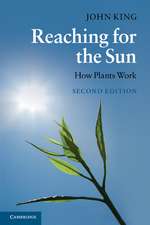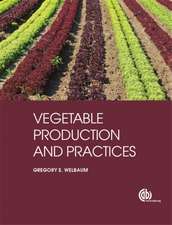Media and Mixes for Container-Grown Plants: A manual on the preparation and use of growing media for pot plants
Autor B. R. Bunten Limba Engleză Paperback – 23 aug 2014
Preț: 782.87 lei
Preț vechi: 954.72 lei
-18% Nou
Puncte Express: 1174
Preț estimativ în valută:
149.82€ • 154.77$ • 124.69£
149.82€ • 154.77$ • 124.69£
Carte tipărită la comandă
Livrare economică 25 martie-08 aprilie
Preluare comenzi: 021 569.72.76
Specificații
ISBN-13: 9789401179065
ISBN-10: 9401179069
Pagini: 332
Ilustrații: XXI, 309 p. 47 illus.
Dimensiuni: 155 x 235 x 22 mm
Greutate: 0.47 kg
Ediția:Softcover reprint of the original 1st ed. 1988
Editura: SPRINGER NETHERLANDS
Colecția Springer
Locul publicării:Dordrecht, Netherlands
ISBN-10: 9401179069
Pagini: 332
Ilustrații: XXI, 309 p. 47 illus.
Dimensiuni: 155 x 235 x 22 mm
Greutate: 0.47 kg
Ediția:Softcover reprint of the original 1st ed. 1988
Editura: SPRINGER NETHERLANDS
Colecția Springer
Locul publicării:Dordrecht, Netherlands
Public țintă
ResearchCuprins
1 Loam or loamless media?.- 1.1 Loam composts.- 1.2 Loamless mixes.- 1.3 Lightweight mixes with some mineral soil.- 2 Materials for loamless mixes.- 2.1 Peat.- 2.2 Bark.- 2.3 Other organic materials.- 2.4 Minerals.- 2.5 Plastics.- 3 Physical aspects.- 3.1 Physical terminology.- 3.2 Bulk density and total pore space.- 3.3 Water relations.- 3.4 Aeration of substrates.- 3.5 Formulating mixes.- 3.6 Wettability of mixes.- 3.7 Compaction.- 4 Principles of nutrition.- 4.1 Cation exchange capacity.- 4.2 Anion exchange capacity.- 4.3 Availability of nutrients: loam v. loamless mixes.- 4.4 Chemical analysis of lightweight media.- 4.5 Nutrient uptake by the plant page.- 4.6 Acidity (pH).- 4.7 Lime requirement.- 4.8 Soluble salts.- 5 Nitrogen.- 5.1 Nitrogen and pot plants.- 5.2 Forms of mineral nitrogen.- 5.3 Slow-release forms.- 5.4 Choice of fertilizer type.- 5.5 Nitrogen and peat.- 6 Other macroelements.- 6.1 Phosphorus.- 6.2 Potassium.- 6.3 Calcium.- 6.4 Magnesium.- 6.5 Sulphur.- 6.6 Slow-release fertilizers.- 6.7 Mineral soil and peat comparison.- 6.8 Nutrient and environment interactions.- 6.9 Fertilizer analysis and salt index.- 6.10 Plant mineral levels.- 6.11 Foliar feeding.- 7 Microelements.- 7.1 Boron.- 7.2 Copper.- 7.3 Manganese.- 7.4 Molybdenum.- 7.5 Iron.- 7.6 Zinc.- 7.7 Chloride.- 7.8 Aluminium.- 7.9 Fritted microelements.- 7.10 Chelated microelements.- 7.11 Inorganic salts and proprietary fertilizers.- 7.12 Other sources.- 7.13 Microelement availability.- 7.14 Foliar sprays.- 8 Mix formulation and preparation page.- 8.1 Historical.- 8.2 Denmark.- 8.3 Finland.- 8.4 Germany.- 8.5 Ireland.- 8.6 Netherlands.- 8.7 Norway.- 8.8 United Kingdom.- 8.9 United States of America.- 8.10 Hardy nursery stock.- 8.11 Azalea mixes.- 8.12 Protea mix.- 8.13 Proprietary formulations.- 8.14 Mix preparation.- 9 Liquid feeding.- 9.1 Principles of feeding.- 9.2 Formulating liquid feeds.- 9.3 Practical aspects of feeding.- 9.4 Injection equipment.- 9.5 Quality of irrigation water.- 10 Irrigation systems.- 10.1 Drip system.- 10.2 Capillary watering.- 10.3 Flooded benches.- 10.4 Overhead sprinklers.- 11 John Innes composts.- 11.1 Formulation.- 11.2 Compost ingredients: loam.- 11.3 Peat.- 11.4 Sand.- 11.5 Pasteurization.- 11.6 Characteristics and use.- 11.7 Composts for calcifuge plants (JIS (A)).- 11.8 Other loam-based mixes.- 12 Heat pasteurization.- 12.1 Thermal deathpoints.- 12.2 Methods of heat pasteurization Page.- 12.3 Steam.- 12.4 Steam-air mixtures.- 12.5 Flame pasteurizer.- 12.6 Electrical pasteurizers.- 12.7 Other methods.- 12.8 Chemistry of heat pasteurization.- 12.9 Rules for heat pasteurization.- 13 Chemical sterilization.- 13.1 Soil fumigants.- 13.2 Soil fungicides.- 13.3 Soil insecticides.- 14 Plant containers, modules and blocks.- 14.1 Clay v. plastic pots.- 14.2 Paper and peat pots.- 14.3 Modules and blocks.- Appendices.- 1 Metric conversions.- 2 Imperial and us capacity measures.- 3 Illumination and solar radiation units.- 4 Atomic weights.- 5 Formulae and molecular weights of some commonly used chemicals.- 6 Formulae and molecular weights of some chemicals commonly used to supply microelements.- 7 Chemical gravimetric conversions.- 8 Temperature conversions.
Recenzii
And for all that you ever wanted to know about compost, read Media for Container Grown Plants - The Independent









